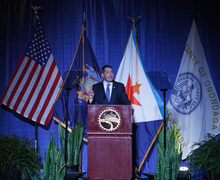SUNY ESF is on its way to improving its pollinator-friendly environment on campus
Dana Fries | Contributing Photographer
SUNY ESF is working with Bee Campus USA to support its pollinator population by planting more native plant species on campus.
To support student journalism and the content you love, become a member of The Daily Orange today.
SUNY ESF is working to increase its pollinator population over the next year with the help of Bee Campus USA.
The organization, which offers resources to member schools to help preserve native pollinators on campus, gave ESF a year to complete its pollinator support plan after the university joined the organization in April. The university’s Bee Campus Committee has focused on planting native species that improve the ecosystem and plan community outreach.
“We are trying to select plants for the campus thoughtfully that hit multiple criteria of benefit for pollinators, people, wildlife, recreational, and cultural use,” said Molly Jacobson, a pollinator specialist at ESF and member of the committee.
The committee, along with student and faculty volunteers, has already held native-species planting days on ESF’s campus. The group planted common milkweed, foxglove beardtongue, stiff goldenrod and Ohio spiderwort, all of which are native to New York state and could attract higher diversity of pollinators to the area, Jacobson said.
Syracuse University has been a Bee Campus USA member since 2019, Jacobson said she was surprised that ESF wasn’t already an affiliate of Bee Campus USA, and she hopes that ESF and SU can work together to support native pollinators.
“We could combine our efforts to make a connected habitat,” Jacobson said. “We could make (the habitats) of better use if we don’t just replicate the same plants.”

Megan Thompson | Digital Design Director
Bee Campus USA also works to help reduce the use of pesticides on campus. ESF’s committee is planning to create an integrated pest management system with the grounds’ crew to address their use of pesticides, Jacobson said.
The committee — which consists of two students, five faculty members, and a grounds supervisor — also plans to hold events such as pollinator walks and native plant sales, she said.
Jacobson said she also wants the committee to inspire the local community to create no-mow lawns and planting native plants. The committee plans to create a website to educate people about the benefits of their initiatives.
If individuals could communicate with their neighbors about planning their yards to include plants that support pollinators, then they could create a species corridor, Jacobson said.
“People underestimate the power of their own yard,” Jacobson said. “You create the landscape.”

Published on October 25, 2022 at 11:19 pm
Contact Dana: dafries@syr.edu





